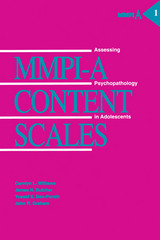4 books about Adolescent psychopathology

Case Studies for Interpreting the MMPI-A
Yossef S. Ben-Porath
University of Minnesota Press, 1996
An instrumental resource for professionals and students working with adolescents.
A landmark for MMPI instruments, this volume will serve as a vital contribution to the expanding base of successful MMPI-A applications. The authors' comprehensive approach to each of the sixteen clinically diverse cases constitutes an intrepretive model providing detailed information on the background of each case, profile validity, current level of adjustment, symptoms and traits, diagnostic and treatment recommendations, and outcome. Particular emphasis is placed on the new adolescent-specific scales developed to assess family and school problems, low self-esteem, and substance abuse.
Including background information on the development of the MMPI-A, the book is a useful resource for those new to the MMPI-A as well as an essential reference for those who have experience in MMPI interpretation with adolescents.
Yossef S. Ben-Porath is associate professor of psychology at Kent State University. Instrumental in the research on and development of the MMPI-A, he has coauthored numerous books on the MMPI-2 and MMPI-A.
Daniel L. Davis is an expert in the area of juvenile delinquency and has had an active career in the treatment and rehabilitation of youth in various programs. He currently works at the Ohio Department of Rehabilitation and Corrections.
[more]

Mental Health Disorders in Adolescents
A Guide for Parents, Teachers, and Professionals
Hazen, Eric P
Rutgers University Press, 2010
Mental Health Disorders in Adolescents provides essential information to help parents, educators, and general practitioners find effective ways to identify and treat psychiatric disorders that many teens face. The first of two reader-friendly sections, "Recognizing the Problem, Finding Help, and Negotiating the System," is designed to help caregivers navigate the often confusing adolescent mental health system. Readers will find comprehensive information about when and how to seek help and the kinds of treatments that are available, including a detailed discussion of psychiatric medications and psychotherapy options. "Common Psychiatric Problems in Adolescence," the second section, offers information on specific psychiatric disorders, including symptoms and warning signs, diagnostic evaluations, treatment options, prognosis, and associated risks for each disorder.
Additionally, Eric P. Hazen, Mark A. Goldstein, and Myrna Chandler Goldstein have compiled two practical appendices-one provides a list of resources, organizations, books, websites, and phone numbers for further information and support. The other serves as a "treatment organizer" to help parents know what school and medical data to bring to a psychiatric evaluation and teach them how to keep track of important discussions related to their child's treatment.
By recognizing the early symptoms of a psychiatric disorder, adults may be able to save a teen's life. Mental Health Disorders in Adolescents offers real options to anyone searching for ways to help at-risk teens.
Additionally, Eric P. Hazen, Mark A. Goldstein, and Myrna Chandler Goldstein have compiled two practical appendices-one provides a list of resources, organizations, books, websites, and phone numbers for further information and support. The other serves as a "treatment organizer" to help parents know what school and medical data to bring to a psychiatric evaluation and teach them how to keep track of important discussions related to their child's treatment.
By recognizing the early symptoms of a psychiatric disorder, adults may be able to save a teen's life. Mental Health Disorders in Adolescents offers real options to anyone searching for ways to help at-risk teens.
[more]

Mmpi-A Content Scales
Assessing Psychopathology in Adolescents
Carolyn L. Williams
University of Minnesota Press, 1992

Origins and Evolution of Behavior Disorders
From Infancy to Early Adult Life
Stella Chess and Alexander Thomas
Harvard University Press, 1987
Beginning in 1956, Stella Chess and Alexander Thomas tracked the lives of 133 children from infancy to young adulthood, examining in detail their psychological development over a twenty-five-year period. The result was the groundbreaking New York Longitudinal Study. This book, first published in 1984, presents a complete report of the study, including analyses of the data and exploration of such fundamental questions as gender differences, antecedents of adult behavior patterns, and factors that contribute to depression and other disorders. Special emphasis is given to the clinical evaluation and treatment of patients with behavioral abnormalities. The authors discuss key findings: the important role of parental guidance, the continuities and discontinuities across developmental stages, the crucial effects of temperament on psychological development, and the usefulness of a “goodness of fit” model for understanding the relationship between person and environment and for describing the evolution of behavior disorders.
[more]
READERS
Browse our collection.
PUBLISHERS
See BiblioVault's publisher services.
STUDENT SERVICES
Files for college accessibility offices.
UChicago Accessibility Resources
home | accessibility | search | about | contact us
BiblioVault ® 2001 - 2024
The University of Chicago Press









